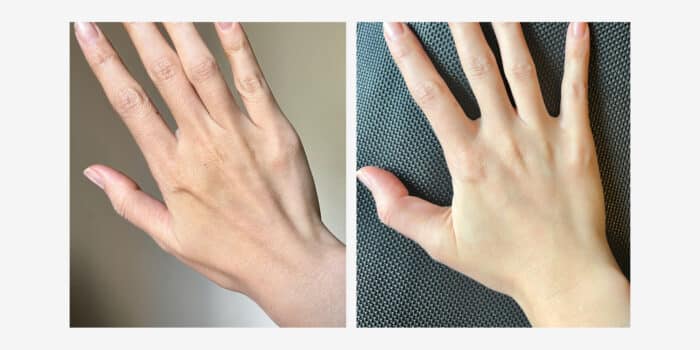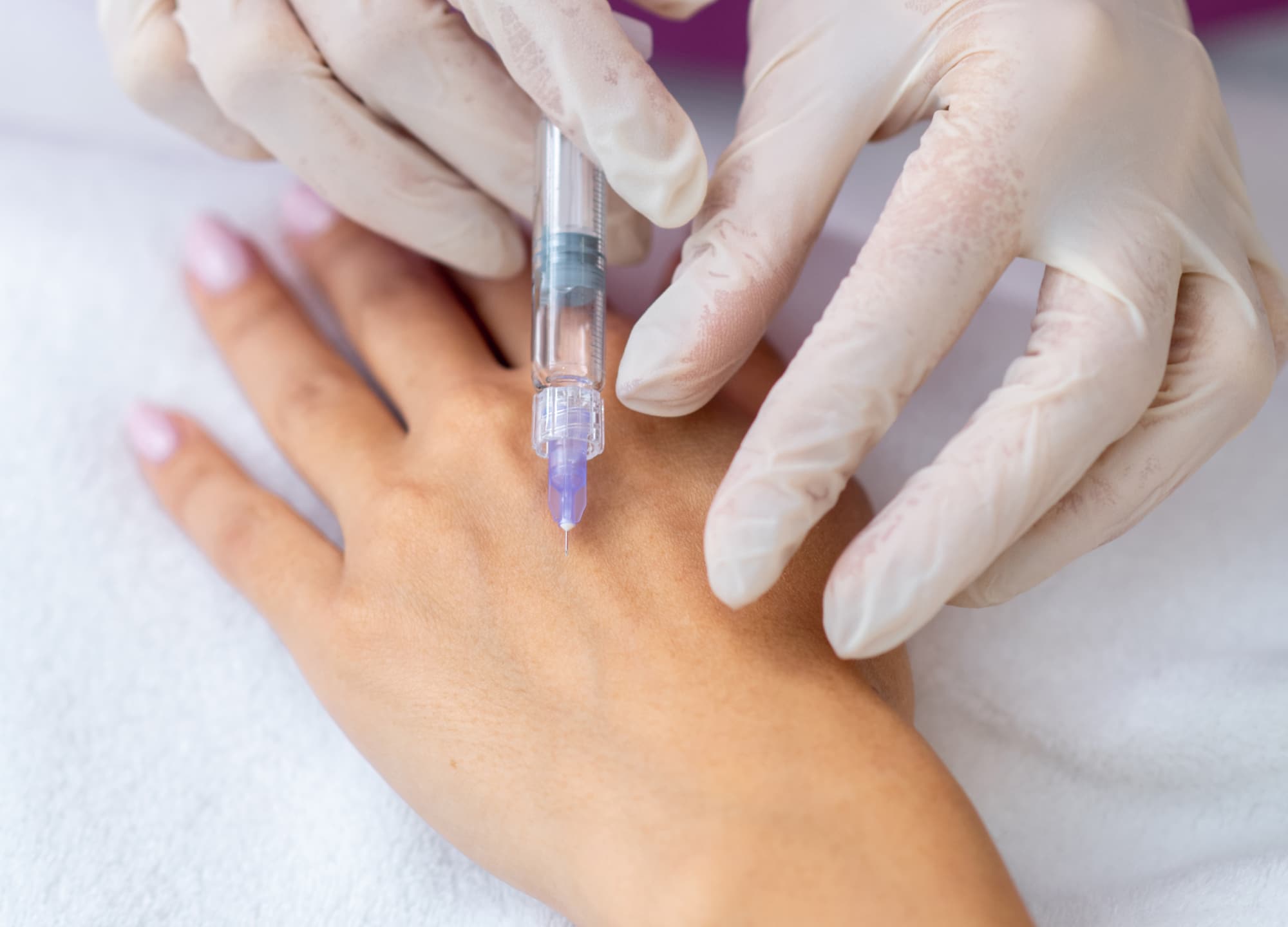The treatment I tried
Renuva, on my hands
My provider
Dr. Haideh Hirmand, a board-certified plastic surgeon in New York City
What is Renuva?
Renuva is an FDA-regulated injectable used to restore age-related volume loss. It’s an allograft adipose matrix derived from purified, donated fat tissue—once injected, it creates a honeycomb-like scaffold around which your own fat cells can grow. Over the course of a few months, it dissolves, replaced by your body’s natural fat. It’s also very versatile: “Renuva can be used anywhere native fat exists. That includes areas such as the face, neck, and décolletage” explains Dr. Hirmand. Common treatment spots include the temples, cheeks, hip dips, and hands, which is where I tried it.
How does Renuva compare to fat transfer?
Whereas traditional fat transfer requires anesthesia and liposuction, Renuva does not. It’s a good option for those who don’t have enough of their own fat or who are ineligible or don’t want to undergo surgery, notes Dr. Hirmand. But because it’s ultimately replaced by the body’s own fat, it still acts as such, delivering long-lasting and natural-looking results, she says. Plus because it’s made from the same components as natural fat, your body doesn’t recognize it as a foreign substance.
Who is a good candidate for Renuva?
According to Dr. Hirmand, almost anyone. “It’s a great treatment for anyone experiencing age-related volume loss. There are very few patients who wouldn’t benefit from this treatment,” she says, noting that the average age of those being treated is between 40-65. It can be used anywhere fat would be used, although it is worth mentioning that it’s not meant to be placed in dermal, glandular, or muscular planes, such as the lips and under the eyes. In these areas, traditional filler would be a better option, Dr. Hirmand says.
Is Renuva safe?
In short, yes. “Renuva has passed rigorous safety testing. It was first used in 2015 for reconstructive uses such as pediatric cleft lip and palate repair, so we have a tremendous amount of knowledge about it,” explains Dr. Hirmand. As with any injectable there are some potential side effects—redness, swelling, bruising, possible tenderness—but those are temporary and only last a few days.
Why I tried Renuva
I started noticing volume loss in the backs of my hands during my late 30s. I’ve always heard the hands are one of those sneaky places that show age first and that it kind of creeps up on you. This is exactly what happened to me: One day I noticed that my hands looked a lot more veiny and had more visible tendons than I remembered. Fat grafting wasn’t something that I was ready for yet, but I also wanted something longer-lasting than traditional filler. I also knew that some types of filler can cause intense swelling, which is something I was trying to avoid. Right around the time when I was trying to figure out what, if anything, I wanted to do to treat the volume loss on my hands, I learned about Renuva. It seemed like the best of both worlds—I would be able to enjoy the effects and longevity of fat transfer with the ease of a filler injectable.
I went to see Dr. Hirmand because she specializes in skin rejuvenation using fat. She and I had a lengthy consultation about Renuva, how it works, its safety profile, and the concerns that I had with my hands. I showed her a picture of what my hands used to look like so we could visualize what I was hoping to get back to. She pointed out that some of what I was seeing was age-related volume loss but other factors, such as skin thinning, were also contributing to the appearance of more prominent veins and tendons. Renuva would be able to restore some of the volume loss, but wouldn’t address the other skin issues. However, she also reassured me that my hands really weren’t that bad and just starting to show signs of aging. We decided that she would take a more conservative approach to the treatment by injecting a smaller amount of Renuva initially, knowing that I could always follow up with a second treatment if needed.
What my Renuva treatment was like
The treatment itself was very straightforward and very much like any type of filler injection. The first step was to clean and sterilize the skin, after which lidocaine was injected around my knuckles where the cannula would be inserted. Although Renuva can be injected via a standard needle, Dr. Hirmand prefers to use a cannula on the backs of the hands to mitigate bruising, since the area is delicate and contains many veins. While the lidocaine was kicking in, Dr. Hirmand reconstituted the treatment matrix, which comes in a preloaded plastic syringe. Using another empty syringe, Dr. Hirmand mixed the treatment with sterile saline and additional lidocaine, transferring the treatment back and forth to homogenize and smooth the product.
She then made about three or four points along the webbing between my knuckles and inserted the cannula through them. She injected a thin layer of Renuva between the tendons along the backs of one hand, where I had noticed volume loss, then repeated the entire process on my other hand. She used less than a syringe of Renuva for the entire procedure, which took only about 20 minutes and was generally painless due to the local anesthesia. The lidocaine injection was probably the part that stung the most.
Following the treatment, my hands were a little pink for about 30 minutes, but I experienced no pain, tightness, or swelling. I’d go so far as to say I didn’t experience any side effects at all. One of the nice things about Renuva is that you can see a result almost immediately, since it instantly adds volume to the area. Over the course of a couple of weeks, that effect dissipates and goes back to baseline as the treatment dissolves, leaving behind the structural matrix for your own body to fill with fat. Final results take about three to six months, but they’re essentially permanent. The new fat that grows in doesn’t go anywhere, but the aging process doesn’t stop. So in 5 to 10 years, even that fat will start to decrease again.
My Renuva results
It’s now been about three months since my treatment. The results are subtle but beautiful. I decided not to go back for a second treatment because I didn’t want an overfilled or unnatural look. I think it’s hard to tell the difference in before and after photos, but in a real life setting, I can definitely see a change. In the same way that I used to catch a glimpse of my hands and think they looked bony, I now catch a glimpse and think they look pretty good and very age appropriate. I can still see tendons and veins, but they don’t jump out at me as much as they used to.

How much Renuva costs
According to RealSelf members, the cost can range from $1,200–$4,800. This is dependent upon your provider’s location, how many ccs are used, and how many treatments you have.
Final verdict
To have such an easy, noninvasive treatment produce results that last years is incredible. I would definitely get Renuva again, not only to refresh my hands but also in my face as I start to lose volume there. I love that it’s a more natural, longer-lasting alternative to fillers, and the results are just beautiful.











